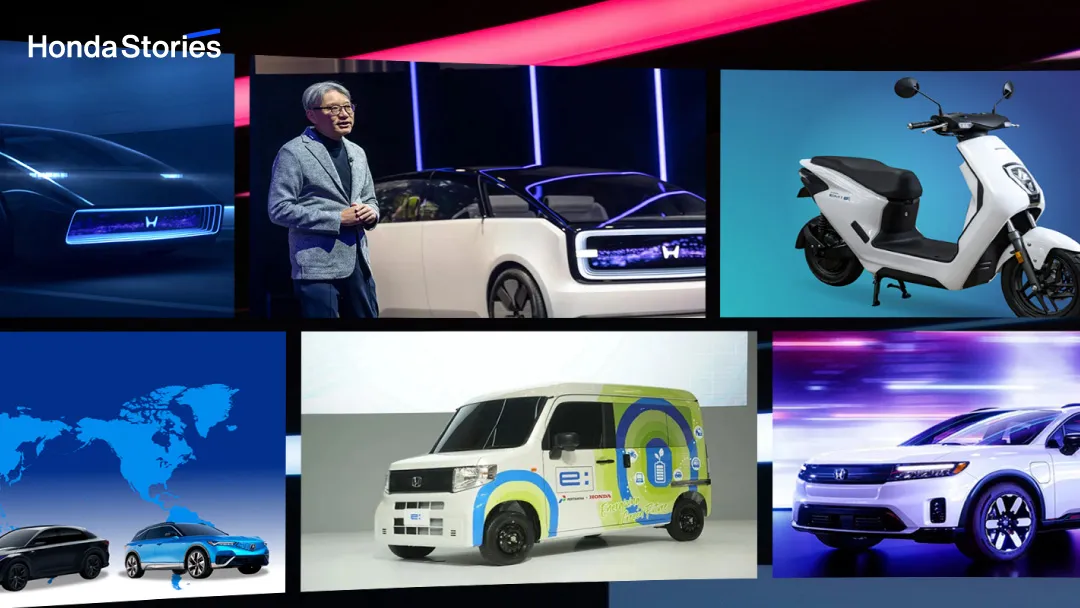Electrification of motorcycles and automobiles is a major pillar toward fulfilling the Honda 2030 Vision statement, to "serve people worldwide with the joy of expanding their life’s potential.”
At the press conference held on April 26, Honda reiterated its direction in promoting electrification and its future plans. Here are some of the highlights from the press conference.
The Aims of Honda’s Electrification Strategy
By 2025, Honda aims to introduce ten or more electric motorcycle models globally, with annual sales of 3.5 million units, or about 15% of Honda's total sales, by 2030.
The BENLY e: is already in use in Japan, Thailand, Vietnam, and other countries alongside the three-wheeled GYRO e:, for businesses such as mail and delivery services. Electric models for general release are also planned, beginning with the EM1 e:, equipped with the Honda Mobile Power Pack e: swappable battery, realizing a top speed of 45 km/h and a range of over 40 km on a single charge. By replacing the battery with a pre-charged Mobile Power Pack, the EM1 e: can be ridden without the need to wait for its battery to recharge. The EM1 e: is planned for launch in Japan, Europe, and Indonesia by the end of 2023.
 EM1 e:
EM1 e:
Honda is also accelerating efforts to achieve its goal to make EVs and FCEVs represent 100% of its global automobile sales by 2040, with plans to produce more than 2 million EVs per year globally by 2030.
In North America, in 2024, Honda and Acura will launch the PROLOGUE and ZDX respectively, models co-developed with General Motors (GM). In 2025, Honda aims to launch a mid- to large-size EV that adopts a new E&E architecture based on Honda's proprietary EV platform.
 PROLOGUE
PROLOGUE
In Japan, Honda plans to launch an N-VAN-based light commercial EV in 2024, an N-ONE-based EV in 2025, and two compact EVs including an SUV type in 2026.
In China, Honda plans to launch the e:NS2 and e:NP2 in early 2024, and a mass-production model based on the e:N SUV 序(xù) concept model unveiled at the Shanghai Motor Show this month, in 2024. Honda aims to introduce ten EV models by 2027, and to achieve a 100% EV sales ratio by 2035, ahead of other regions.
Resilient Value Chain to Realize Electrification
For the time being, Honda will continue to procure batteries from external partners. In North America, Honda will procure "Ultium" lithium-ion batteries from GM and establish a production joint venture with LG Energy Solutions by the end of 2023. In China, Honda will strengthen its partnership with Contemporary Amperex Technology (CATL), the world's largest manufacturer of automotive batteries, and in Japan it will procure batteries for light commercial EVs from Envision AESC.
From the late 2020s onward,Honda will accelerate not only external procurement but also its own R&D. In addition to developing high-capacity, high-power lithium-ion batteries for EVs in a cooperating company with GS Yuasa, Honda will launch an all-solid-state battery test line in 2024, aiming to use the batteries in models to be introduced in the late 2020s. In addition, Honda will continue to take on the challenge of technological evolution through various means, such as investing in SES, an EV battery R&D company in the U.S., to jointly develop semi-solid-state batteries (lithium metal secondary batteries).
In addition to procurement and development, Honda expects the areas of resource procurement and resource circulation to become increasingly important in the future.
With regards to resource procurement,Honda will leverage its strategic partnership with Hanwa Kogyo, which was signed in 2022, to achieve stable procurement of rare metals such as nickel, cobalt, and lithium over the medium to long term.
Regarding resource recycling, Honda has reached a basic agreement to collaborate with Ascend Elements and Cirba Solutions, both of which are resource recycling firms in North America. In addition to stabilizing material procurement, Honda aims to achieve zero environmental impact. In addition, through the recently announced comprehensive partnership with POSCO Holdings, Honda will work to improve sustainability in the procurement of key materials.
In this way, in aiming for high value-added batteries, Honda will form strategic partnerships with various companies, from battery and resource procurement to resource circulation, to build a strong value chain with Honda as its hub and establish a sustainable business foundation.

The Five Key Factors in Realizing Ideal Mobility
Honda has set two goals, to create a society where all people can enjoy the joy and freedom mobility: Zero environmental impact (carbon neutrality), and zero traffic fatalities. To realize these challenges, Honda has defined five key factors to evolve mobility while strengthening its business structure.

Promoting this electrification strategy is one of the key factors in this mission and is an initiative that holds the key to the future of mobility. Honda will continue to strive to provide continuous value to society, and to each of its customers.
Original article issued on April 26, 2023
<Related Articles>



![[Infographic] Understanding Honda's Automobile Electrification Strategy in Three Minutes - Exploring the Environment that Surrounds Electric Vehicles and Honda's Vision](/content/dam/site/global-en/stories/cq_img/075/social.jpg)

![[5-minute story] Striving for Carbon Neutrality of Motorcycles as a Responsibility of the World’s Largest Motorcycle Manufacturer](/content/dam/site/global-en/stories/cq_img/040/social.jpg)




